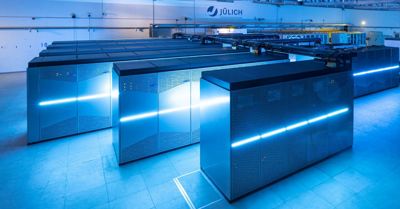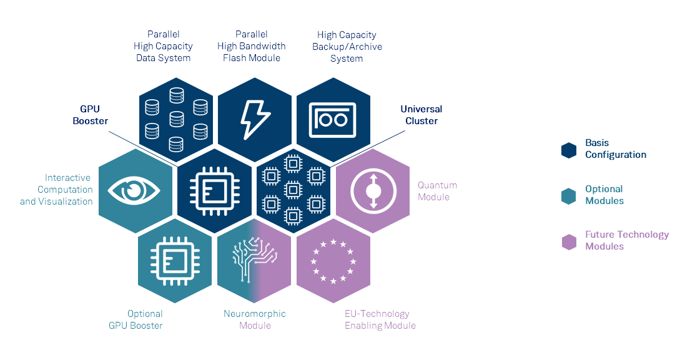First European Exascale HPC Coming to Jülich
Which will bear the name JUPITER (short for Joint Undertaking Pioneer for Innovative and Transformative Exascale Research)
This is a Press Release edited by StorageNewsletter.com on June 28, 2022 at 2:02 pmEuroHPC JU European HPC Joint Undertaking, has selected Forschungszentrum Jülich GmbH, a partner in Germany’s Gauss Centre for Supercomputing e.V (GCS), to operate the first next-gen European HPC.
It’s been decided: Forschungszentrum Jülich will be home to Europe’s first exascale computer. The HPC is set to be the first in Europe to surpass the threshold of one trillion calculations per second. The system will be acquired by the European supercomputing initiative EuroHPC JU. The exascale computer should help to solve important and urgent scientific questions regarding, for example, climate change, how to combat pandemics, and sustainable energy production, while also enabling the intensive use of AI and the analysis of large data volumes. The overall costs for the system amount to €500 million. Of this total, €250 million is being provided by EuroHPC JU and a further €250 million in equal parts by the German Federal Ministry of Education and Research (BMBF) and the Ministry of Culture and Science of the State of North Rhine-Westphalia (MKW NRW).
Germany’s fastest HPC JUWELS at Forschungszentrum Jülich, which is funded in equal parts by the Federal Ministry of Education and Research (BMBF)
and the Ministry of Culture and Science of the State of North Rhine-Westphalia (MKW NRW) via the Gauss Centre for Supercomputing (GCS).

The computer, which will bear the name JUPITER (short for Joint Undertaking Pioneer for Innovative and Transformative Exascale Research), will be installed as of 2023 in a specially designed building on the campus of Forschungszentrum Jülich. It is intended that the system will be operated by the Jülich Supercomputing Centre (JSC), whose HPCs JUWELS and JURECA currently rank among the most powerful in the world. JSC had participated in the application procedure for a high-end HPC as a member of the Gauss Centre for Supercomputing (GCS), an association of the 3 national supercomputing centres JSC in Jülich, HPC Center Stuttgart (HLRS), and Leibniz Computing Centre (LRZ) in Garching. The competition was organized by the European supercomputing initiative EuroHPC JU, which was formed by the EU together with European countries and private companies.
The final decision on the location of Europe’s first exascale computer was taken by EuroHPC in Kajaani, Finland, during the inauguration of Europe’s first-ever pre-exascale computer. LUMI, the fastest HPC in Europe since the beginning of June, is ranked third on the current TOP500 list of the world’s most powerful HPCs. For the first time, an exascale computer has officially been at the top of this list since May: the US HPC Frontier.
JUPITER is set to become the first European HPC to make the leap into the exascale class. In terms of computing power, it will be more powerful than 5 million modern laptops or PCs. Just like Jülich’s current HPC JUWELS, JUPITER will be based on a dynamic, modular supercomputing architecture, which Forschungszentrum Jülich developed together with European and international partners in the EU’s DEEP research projects.
In a modular HPC, various computing modules are coupled together. This enables program parts of complex simulations to be distributed over several modules, ensuring that the various hardware properties can be optimally utilized in each case. Its modular construction also means that the system is well prepared for integrating future technologies such as quantum computing or neuromorphic modules, which emulate the neural structure of a biological brain.
Computing and storage modules of the exascale computer in its basic configuration (blue) as well as optional modules (green)
and modules for future technologies (purple) as possible extensions

In its basic configuration, JUPITER will have an enormously powerful booster module with highly efficient GPU-based computation accelerators. Massively parallel applications are accelerated by this booster in a similar way to a turbocharger, for example to calculate high-resolution climate models, develop new materials, simulate complex cell processes and energy systems, advance basic research, or train next-gen, computationally intensive machine-learning algorithms.
One major challenge is the energy that is required for such large computing power. The average power is anticipated to be up to 15 megawatts. JUPITER has been designed as a “green” HPC and will be powered by green electricity. The envisaged warm water cooling system should help to ensure that JUPITER achieves the highest efficiency values. At the same time, the cooling technology opens up the possibility of using the waste heat that is produced. For example, just like its predecessor system JUWELS, JUPITER is set to be connected to the low-temperature network on the Forschungszentrum Jülich campus. Further potential applications for the waste heat from JUPITER are currently being investigated by Forschungszentrum Jülich.














 Subscribe to our free daily newsletter
Subscribe to our free daily newsletter

